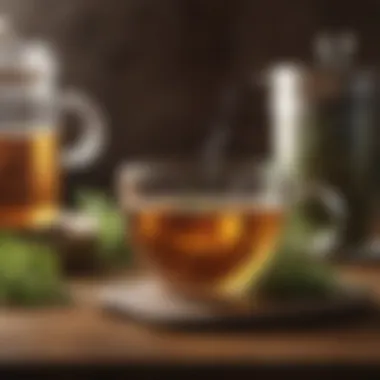Effective Remedies for Managing High Blood Pressure


Intro
Hypertension, commonly known as high blood pressure, is a prevalent condition affecting millions of individuals worldwide. It often goes unnoticed, yet its implications are significant. If untreated, hypertension can lead to severe complications, including heart disease and stroke. Understanding how to manage and mitigate high blood pressure is essential for overall health and well-being.
This article presents a systematic approach to remedies available for controlling high blood pressure. It covers lifestyle changes, dietary adjustments, and natural therapies that can yield positive outcomes. By focusing on evidence-based remedies, we aim to provide clarity and actionable insights for those grappling with hypertension.
Importance of the Research
Research into hypertension is critical as it underscores the importance of preventative approaches. With hypertension linked to increased risk of numerous health issues, effective management strategies become vital in reducing this risk.
Results and Discussion
Presentation of Findings
Many studies underline the role of lifestyle modifications in controlling blood pressure. Key findings suggest that reducing sodium intake, engaging in regular exercise, and maintaining a healthy body weight significantly contribute to managing hypertension.
In addition, natural remedies like certain herbs and supplements show promise. For instance, garlic and omega-3 fatty acids have been researched for their potential blood pressure-lowering effects.
Implications of Results
These findings shed light on practical steps individuals can adopt. Awareness regarding dietary choices and the benefits of physical activity can empower patients. Moreover, the findings also signal healthcare providers to recommend personalized management plans including both lifestyle changes and natural remedies.
"Managing high blood pressure effectively often requires a multi-faceted approach that incorporates both lifestyle adjustments and timely medical intervention."
Finale
Understanding High Blood Pressure
High blood pressure, also known as hypertension, is a condition that has significant implications for health. Understanding its nuances is essential for effective management and prevention. This foundational knowledge enables individuals to grasp how lifestyle choices, medical interventions, and natural remedies play a role in controlling blood pressure levels. By comprehending the definition, causes, risk factors, and health implications, individuals can proactively engage in strategies that might help them lower their blood pressure.
Definition and Causes
High blood pressure is defined as a condition where the force of the blood against the artery walls is consistently too high. Blood pressure is measured in millimeters of mercury (mmHg) and is expressed with two numbers. The first number, systolic pressure, measures the pressure in arteries when the heart beats. The second number, diastolic pressure, gauges the pressure when the heart is resting between beats. A normal reading is typically around 120/80 mmHg.
The causes of high blood pressure can be multifaceted. Some individuals have primary hypertension, which develops gradually over many years without a clear cause. Others experience secondary hypertension, which can arise from underlying conditions such as kidney disease, hormonal disorders, or certain medications. Factors such as age, genetics, diet, and lifestyle choices impact blood pressure levels as well.
Risk Factors
Numerous risk factors contribute to high blood pressure, and recognizing these can help in prevention and management. Key factors include:
- Age: The risk increases with age, particularly for individuals over 45.
- Family History: A family history of hypertension may enhance one’s risk.
- Obesity: Excess weight places additional strain on the heart.
- Physical Inactivity: A sedentary lifestyle can lead to weight gain and elevated blood pressure.
- Diet: High sodium consumption is known to raise blood pressure.
- Alcohol Consumption: Excessive drinking can affect overall health and blood pressure.
- Stress: Chronic stress may contribute to temporarily increased blood pressure levels.
The interplay of these factors is crucial to understand as it can guide preventive measures.
Health Implications
Left unmanaged, high blood pressure can lead to grave health consequences. It stresses the heart and arteries, increasing the risk for heart disease, stroke, and chronic kidney disease. Other conditions such as heart failure and vision impairment can also arise due to prolonged hypertension. Research demonstrates that early intervention is vital. Regular monitoring and lifestyle modifications can significantly reduce the risk of developing serious health issues related to high blood pressure.
By recognizing the seriousness of high blood pressure and understanding its causes and implications, individuals can embark on a journey toward better health. Knowledge empowers action, laying the groundwork for effective management strategies that can improve quality of life.
Lifestyle Modifications
Lifestyle modifications play a crucial role in managing high blood pressure. They can significantly lower risk factors associated with hypertension, making a large impact on overall health. Choosing healthier lifestyles is not just about avoiding medication; it is about making conscious, informed decisions every day.


Implementing these changes can lead to long-term improvements in blood pressure levels. Not only can they mitigate the symptoms of hypertension, but they can also enhance your quality of life. Changes in diet, incorporating physical activity, and maintaining a healthy weight contribute to a robust strategy for blood pressure management.
Dietary Changes
Reducing Sodium Intake
Reducing sodium intake is often one of the most important dietary changes recommended for those with high blood pressure. Sodium intake is linked to fluid retention, which can drive blood pressure up. People are often advised to limit their sodium to 2,300 mg per day, or even lower, when health conditions exist.
Notably, this adjustment is a popular choice in the context of blood pressure control. The unique feature of reducing sodium intake is its swift impact; many may notice lower blood pressure in just weeks after making dietary changes. However, a potential disadvantage is the difficulty some people may face in adjusting their taste preferences since many processed foods contain high sodium levels.
Increasing Potassium Consumption
Increasing potassium consumption can significantly counteract the effects of sodium. Foods rich in potassium such as bananas, sweet potatoes, and spinach help in balancing fluids in the body. This leads to relaxation of the blood vessel walls, reducing blood pressure.
The key characteristic of potassium is its natural ability to balance electrolytes, which is vital for heart health. Embracing potassium-rich foods is seen as a beneficial choice for managing hypertension. However, for individuals with certain health issues, such as kidney disease, excessive potassium can be problematic.
Embracing a Mediterranean Diet
Embracing a Mediterranean diet is another effective strategy to manage blood pressure. This diet emphasizes fruits, vegetables, whole grains, and healthy fats like olive oil. Studies consistently show that following this dietary pattern can lead to better heart health outcomes, including lower blood pressure.
The diet's key characteristic lies in its anti-inflammatory properties and antioxidants that promote cardiovascular health. It is a popular choice because it also encourages overall wellness beyond just blood pressure management. That said, transitioning to this diet might feel restrictive to some initially, as it emphasizes whole foods over processed options.
Physical Activity
Importance of Regular Exercise
The importance of regular exercise cannot be overstated in managing high blood pressure. Engaging in physical activity can help reduce blood pressure and improve heart function. The recommended amount is at least 150 minutes of moderate aerobic activity each week.
A key characteristic is that it fosters not just short-term relief but long-term health benefits. It is beneficial because it helps in weight management and stress reduction, both crucial to mitigating hypertension. Potential drawbacks might include time constraints or physical limitations some individuals face.
Types of Beneficial Activities
Different types of activities can be beneficial when it comes to lowering blood pressure. Aerobic exercises such as walking, swimming, and cycling have shown positive effects on heart health. Strength training and flexibility exercises are also helpful.
The unique feature of these activities lies in their versatility. People can find various enjoyable activities that fit their lifestyles. However, the challenge may lie in consistency; many find it hard to stick to a routine amid busy schedules.
Setting Realistic Fitness Goals
Setting realistic fitness goals is essential for sustained success in managing blood pressure. It allows individuals to create achievable targets for their activity levels. Goals should be specific, measurable, and tailored to their circumstances.
This approach is beneficial because it fosters motivation and can lead to a sense of accomplishment. It also promotes a gradual adjustment to an active lifestyle, reducing the likelihood of burnout. However, setting goals that are too ambitious can lead to frustration when they are not met.
Weight Management
Effective weight management is another vital lifestyle modification that can aid in controlling high blood pressure. Maintaining a healthy weight reduces the strain on the heart and can lead to better blood pressure numbers.
A weight loss of just 5 to 10 percent can derive significant benefits in improving overall cardiovascular health. This process involves a combination of dietary approaches and physical activity tailored to the individual’s needs. Tracking one’s weight regularly might be recommended as a motivating factor, though some may find this daunting.
Overall, lifestyle modifications represent a powerful means to influence blood pressure in a constructive manner. Such changes not only help in achieving better blood pressure control but also enhance general wellness.
Natural Remedies
While many remedies boast anecdotal support, it is crucial to consider the scientific evidence behind their efficacy. Understanding the unique properties of various natural options helps individuals make informed decisions about their health. Emerging research continues to uncover benefits, which enhances credibility among those skeptical of these methods.


Herbal Supplements
Garlic Extract
Garlic extract is known for its ability to support cardiovascular health. Its main component, allicin, has shown potential in lowering blood pressure. This compound promotes vasodilation, which enhances blood flow by relaxing blood vessels. Garlic has the added benefit of being a low-cost and accessible option for many. However, some people may experience digestive discomfort when consuming garlic in large amounts.
Green Tea
Green tea has long been revered for its health benefits, particularly its antioxidants. The polyphenols found in green tea have been associated with improved arterial function. Regular consumption can potentially lead to modest reductions in blood pressure. Though the caffeine content in green tea may concern some, moderate intake is generally safe for most individuals.
Omega-3 Fatty Acids
Omega-3 fatty acids, commonly found in fish oil, hold considerable importance in heart health. Their anti-inflammatory properties can lead to reduced blood pressure, especially in individuals with hypertension. Eating fatty fish, like salmon and mackerel, can be an effective way to incorporate these acids. Some may prefer supplements, but it is essential to consult with a healthcare provider regarding appropriate dosage.
Home Remedies
Apple Cider Vinegar
Apple cider vinegar is popular in natural remedies, often touted for its myriad health benefits. Research indicates that it may positively affect blood pressure regulation. Its acetic acid content is believed to improve metabolism and aid weight management. Despite its benefits, the strong acidity can erode tooth enamel and irritate the throat if consumed undiluted.
Hibiscus Tea
Hibiscus tea is derived from the hibiscus flower and known for its striking color and health properties. Studies suggest that regular consumption may lead to significant reductions in blood pressure. This herbal tea contains antioxidants and may have diuretic effects. However, people on certain medications, particularly blood thinners, should consult their physician before adding it to their diet.
Beetroot Juice
Beetroot juice is rich in nitrates, which can enhance blood flow and reduce blood pressure. Drinking beetroot juice may provide noticeable automatic effects on blood pressure. It's a flavorful addition to smoothies or can be consumed alone. The taste may not appeal to everyone, and high consumption should be moderated due to its potential effects on urine color, which can be alarming but harmless.
Essential Oils and Aromatherapy
Essential oils have garnered attention for their potential therapeutic properties. Some oils, like lavender and bergamot, might help reduce anxiety and promote relaxation. Inhaling their scents or using them in diffusers could support overall wellness by fostering a tranquil environment. However, one must ensure that they use essential oils safely, as some may cause skin irritation or allergic reactions if misused.
"Understanding natural remedies is essential for those seeking to augment their approach to managing high blood pressure. The blend of lifestyle changes and natural supplements can be key components for achieving optimal health."
Alternative Therapies
Alternative therapies have gained attention in recent years as supplementary methods for managing high blood pressure. These practices often focus on holistic approaches to improve overall health and well-being. The significance of incorporating alternative therapies lies in their potential to complement traditional medical treatments. They may help reduce stress, enhance relaxation, and improve bodily functions, which can contribute to lower blood pressure levels.
Acupuncture
Acupuncture is an ancient practice rooted in Traditional Chinese Medicine. It involves inserting thin needles into specific points on the body to promote healing. Many studies suggest that acupuncture can help lower blood pressure. The proposed mechanism includes improved blood circulation and reduced stress hormones. Some people find it effective for anxiety and tension, which are often linked to high blood pressure.
"Acupuncture may alter the body’s response to stress, potentially leading to lower blood pressure levels."
While acupuncture is generally considered safe, it is crucial to consult a qualified practitioner. Individuals should ensure they choose an acupuncturist who is licensed and follows proper hygiene standards. Before trying acupuncture, discussing any underlying health issues with a healthcare professional is wise.
Yoga and Meditation
Yoga and meditation are powerful practices that combine physical movements with mental focus. They can help reduce stress, which is a known contributor to high blood pressure. Research indicates that these practices can lead to significant reductions in both systolic and diastolic blood pressure.
- Benefits of Yoga:
- Benefits of Meditation:
- Enhances flexibility and strength.
- Promotes relaxation through deep breathing.
- Encourages mindfulness, which can help reduce anxiety.


- Helps manage stress and anxiety levels.
- Improves emotional health.
- May enhance self-awareness and focus.
Engaging in regular yoga sessions and incorporating meditation into daily routines can yield long-term benefits for managing blood pressure. It is helpful to start with guided sessions, especially for beginners.
Biofeedback
Biofeedback is a technique that teaches individuals how to control physiological functions by using monitoring devices. In the context of high blood pressure, biofeedback can provide real-time data about heart rate, muscle tension, and even blood pressure. This feedback enables individuals to learn relaxation techniques that can lower their blood pressure effectively.
Some key points about biofeedback include:
- Training: Individuals receive training to use relaxation techniques, such as deep breathing or visualization.
- Equipment: Biofeedback devices can range from simple monitors to advanced software that provides detailed information.
- Customization: This therapy can be tailored to individual needs, allowing for personalized management of blood pressure.
Overall, alternative therapies offer various approaches to support the management of high blood pressure. Each modality provides unique benefits and can be incorporated alongside traditional treatment methods. However, individuals must consult healthcare professionals before making significant changes to their health management plans.
Monitoring Blood Pressure
Monitoring blood pressure is a crucial aspect of managing hypertension. It helps individuals stay informed about their health status and ensures that any potential issues are addressed promptly. Regular monitoring allows for early detection of changes in blood pressure, which can be lifesaving. There are several approaches to monitoring, each bringing unique benefits.
Importance of Regular Check-ups
Regular check-ups with a healthcare provider are essential in managing high blood pressure. These visits allow for thorough assessments and ensure that hypertension is not only addressed but also understood in its broader context. They provide individuals a chance to ask questions and discuss treatment options. Moreover, healthcare professionals can evaluate the effectiveness of existing therapies and make adjustments as needed.
According to health experts, anyone with a risk of hypertension should see a professional at least once a year. For those diagnosed with high blood pressure, more frequent visits may be advisable. This approach ensures that individuals remain proactive about their health, thereby preventing further complications.
Home Monitoring Techniques
Home monitoring of blood pressure has become increasingly popular due to its convenience and accessibility. With the right tools, individuals can easily measure their blood pressure in a familiar environment. Common devices include digital blood pressure cuffs, which are user-friendly and relatively inexpensive.
To effectively monitor blood pressure at home:
- Choose a reliable device: Ensure it is validated for accuracy.
- Follow instructions meticulously: Proper placement of the cuff is critical.
- Record readings consistently: Document results, noting the date and time.
By consistently tracking blood pressure from home, individuals can relayed data back to their doctors, enhancing the management plan.
Interpreting Blood Pressure Readings
Interpreting blood pressure readings correctly is vital for effective management of hypertension. Blood pressure readings are composed of two numbers: systolic and diastolic pressure. The systolic number appears first and measures the pressure in the arteries when the heart beats. The diastolic number measures the pressure in the arteries when the heart rests between beats.
- Normal Reading: Below 120/80 mm Hg
- Elevated Reading: Systolic between 120-129 and diastolic below 80
- Hypertension Stage 1: Systolic 130-139 or diastolic 80-89
- Hypertension Stage 2: Systolic 140 or higher or diastolic 90 or higher
- Hypertensive Crisis: Systolic over 180 and/or diastolic over 120 (requires immediate medical attention)
Understanding these figures can empower individuals to take necessary action. For instance, if readings consistently indicate stage 1 hypertension, lifestyle adjustments or medications may be necessary.
Monitoring blood pressure is an integral part of managing hypertension effectively. Noticing changes early can prevent severe health issues down the line.
Consulting Healthcare Professionals
Consulting healthcare professionals is a critical aspect of managing high blood pressure effectively. While lifestyle changes and natural remedies can play a significant role, professional advice brings a more structured and medically sound approach to control hypertension. Healthcare providers offer tailored strategies, ensuring that individuals receive the most suitable interventions based on their health status. The conversation with a healthcare professional can also help clarify any misconceptions about hypertension, its consequences, and treatment options.
When to Seek Medical Advice
Recognizing when to seek medical advice for high blood pressure is essential. If an individual experiences symptoms such as severe headaches, shortness of breath, or chest pain, immediate medical attention is necessary. Regular blood pressure monitoring can also signal when to consult a doctor. If readings consistently exceed 130/80 mmHg, it may be time to make an appointment. Regular check-ups are beneficial, particularly for those with risk factors like obesity, diabetes, or a family history of hypertension. In these situations, preemptive discussions can mitigate long-term health risks.
Collaborative Care Strategies
Collaborative care strategies emphasize teamwork between the individual and their healthcare team. This can include regular engagement with primary care physicians, nutritionists, and exercise specialists. The involvement of multiple disciplines ensures a holistic approach to managing high blood pressure. Effective communication is key. Patients should feel comfortable discussing their concerns, lifestyle habits, and adherence to medications. This exchange of information allows healthcare providers to better adjust treatment plans, promoting a more effective management of hypertension.
Pharmacological Options
Pharmacological options are crucial for individuals who cannot manage their blood pressure through lifestyle modifications alone. Several classes of medications exist, each serving distinct purposes. Common categories include diuretics, ACE inhibitors like Lisinopril, calcium channel blockers, and beta-blockers. Each medication has specific indications and potential side effects. A healthcare professional can help determine the most suitable choice, considering individual health profiles. It is vital for patients to openly discuss any concerns about side effects or efficacy with their doctors. Regular follow-ups are necessary to track progress and make adjustments as needed.
Effective management of high blood pressure often requires a combination of lifestyle changes and medication prescribed by healthcare professionals.















